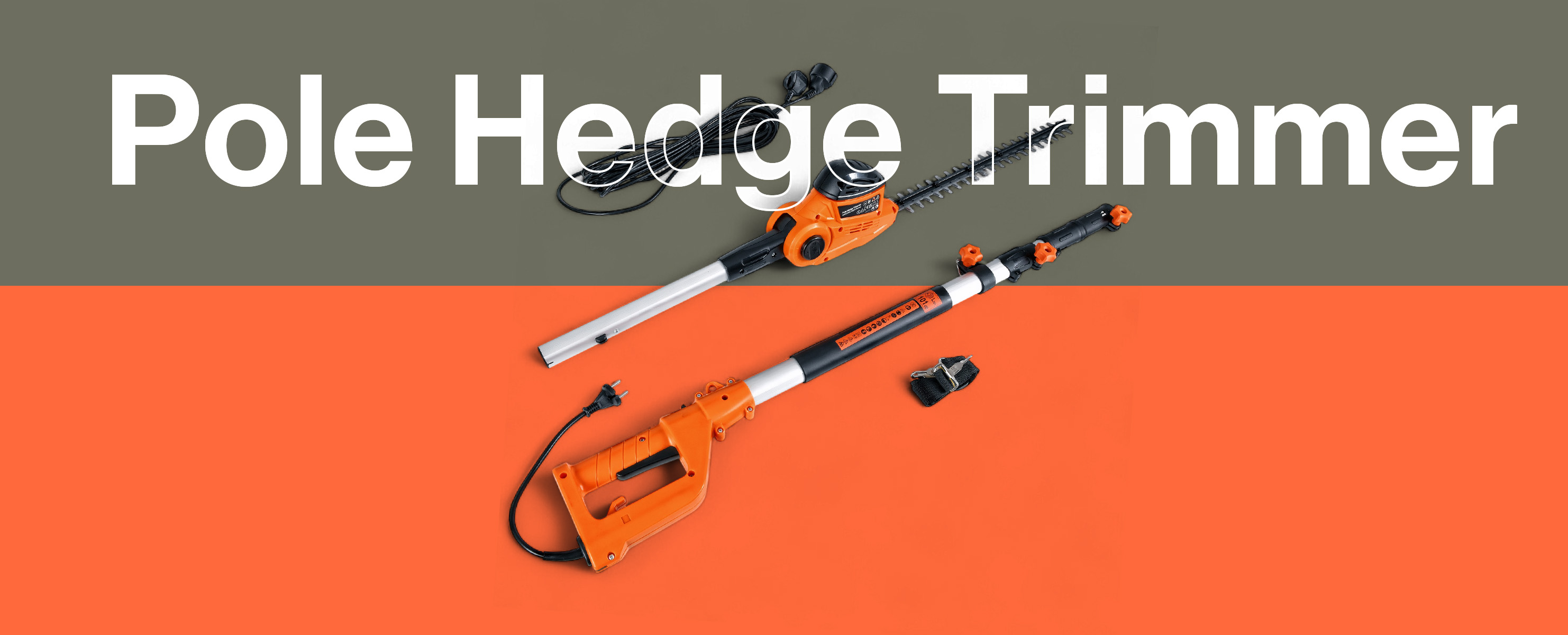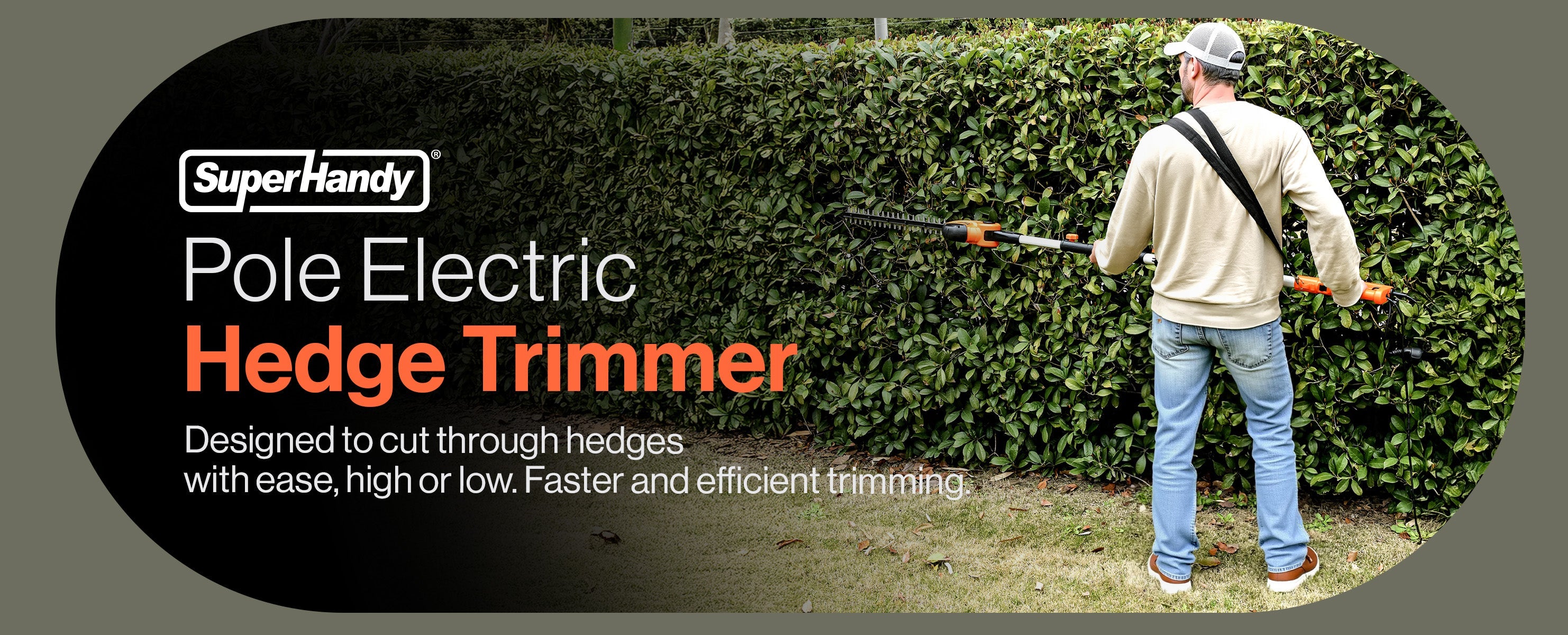You keep your pole hedge trimmer working well and safe by looking after it often. Easy habits make it simple for anyone to care for garden machinery. When you look after your tools, they work better. They break down less often. They last longer. Your tools are always ready for any job.
Key Takeaways
-
Clean your pole hedge trimmer after each use. This removes dirt, sap, and bits of plants. Cleaning stops rust. It keeps the blades sharp. It helps your tool last longer.
-
Check, oil, and sharpen the blades often. This makes cutting safe and easy. Change broken parts right away. This helps stop accidents.
-
Keep your trimmer in a dry and safe spot. Take care of the battery or fuel as told. Storing it well keeps your tool safe. It helps your trimmer last longer.
Clean Your Pole Hedge Trimmer
Keeping your pole hedge trimmer clean is a key part of daily maintenance. You protect your tools and keep them sharp when you clean your hedge trimmer after every use. Dirt, sap, and plant debris can build up quickly. This build-up can cause rust and make your blades dull. Clean tools last longer and work better.
Remove Dirt and Debris
Start by making sure your pole hedge trimmer is switched off and unplugged. Use a stiff brush to remove loose dirt and leaves from the blades and body. Pay close attention to areas where sap collects. Removing sap at this stage makes the next steps easier. You can use a plastic scraper for stubborn bits.
Wipe Down Exterior
Take a damp cloth and wipe down the outside of your tools. This step helps remove any sticky sap or resin left behind. If you see any stubborn sap, try a little soapy water. Always dry your tools with a clean towel to stop rust from forming. Daily maintenance like this keeps your pole hedge trimmer looking new.
Clean Blades After Use
You must clean hedge trimmer blades every time you finish a job. Use a cloth soaked in a mild cleaning solution to wipe the blades. Focus on removing sap and plant residue. For heavy sap, use a special cleaner made for garden tools. Clean hedge trimmer blades cut better and last longer. Proper daily care and regular cleaning help prevent corrosion and keep your tools in top shape.
Tip: Always wear gloves when you clean your hedge trimmer. This keeps your hands safe from sharp blades and sticky sap.
Blade Maintenance

Inspect for Wear
You should check your blades before every use. Look for chips, cracks, or bends. Damaged blades can make your tools unsafe. If you see any problems, stop using your hedge trimmer. Replace worn blades as soon as possible. This step keeps your tools working well and helps you avoid accidents. Regular inspection is a key part of good maintenance.
Lubricate Blades
Blades need oil to move smoothly. After you clean your hedge trimmer, apply a light machine oil to the blades. Use a cloth to spread the oil evenly. Lubrication stops rust and keeps your tools sharp. It also makes cutting easier. You should lubricate after every use, especially if you use your tools often. Well-oiled blades last longer and work better.
Tip: Always wear gloves when you oil the blades. This keeps your hands safe from sharp edges.
Sharpen Regularly
Sharp blades give you a clean cut. Dull blades tear branches and make your work harder. You should sharpen your blades at least once each season. Use a sharpening stone or a file made for garden tools. Follow the angle of the blade for best results. Sharpening your tools helps you keep your hedge trimmer in top shape. If you do not feel sure about sharpening, ask a professional for help.
A good maintenance routine includes cleaning, oiling, and sharpening. These steps keep your tools ready for any job.
Check Fasteners and Fittings
Regular checks on fasteners and fittings help you keep your pole hedge trimmer safe and reliable. You protect your tools from damage when you pay attention to these small parts. Good maintenance habits stop problems before they start.
Tighten Screws and Bolts
Loose screws and bolts can cause your tools to vibrate or even fall apart during use. You should check all screws and bolts before each job. Use the correct screwdriver or spanner for your model. Tighten any loose parts, but do not overtighten. Overtightening can strip threads or break the fittings. If you find a missing screw or bolt, replace it straight away. This step keeps your tools working as they should.
Tip: Make a checklist for your maintenance routine. Tick off each step as you go. This helps you remember every part of your tools.
Inspect Gear Case
The gear case connects the motor to the blades. You need to check this area for cracks, leaks, or signs of wear. If you see oil leaking or hear strange noises, stop using your tools. These signs mean you may need a repair. Clean the gear case with a dry cloth. Avoid using water near this part. A well-kept gear case helps your tools run smoothly and last longer.
You keep your tools in top condition when you check fasteners and fittings often. This simple maintenance step saves you time and money in the long run.
Storage for Longevity
Proper storage keeps your pole hedge trimmer in top shape. You help your tools last longer by storing them the right way. Good storage habits stop rust and corrosion. You also avoid accidental damage. This supports tool longevity and gives you long-lasting equipment.
Dry Storage
You should always store your tools in a dry place. Moisture can cause rust and damage both wood and metal parts. A dry shed or garage works well. Make sure you clean your hedge trimmer before extended storage. Wipe off any dirt or sap. This step helps with preventing rust and protecting wood and metal. You keep your tools ready for the next season.
Tip: Hang your pole hedge trimmer on a wall hook to keep it off the ground and away from damp areas.
Drain Fuel
If you use a petrol model, drain the fuel before you put your tools away for a long time. Old fuel can damage the engine and make starting hard. You can use a fuel stabiliser if you plan to store your tools for only a few weeks. Always clean before extended storage to avoid sticky build-up. This is a key part of seasonal tool care and long-term care.
Protect from Damage
Store your tools in a safe spot where nothing can fall on them. Use blade covers to protect the sharp edges. You keep your tools clean and safe by checking the storage area often. Good habits help you enjoy longevity and reliable performance.
Regular Inspection for Tool Longevity
Check for Wear and Damage
You should inspect your pole hedge trimmer often. Look for cracks, rust, or loose parts. Check the blades for chips or bends. Examine the handles and switches for signs of wear. If you spot any damage, stop using your tool. Early detection helps you avoid bigger problems. You can prevent accidents by acting quickly. Sometimes, you may need a replacement part to keep your trimmer safe. Always use the correct parts for your model.
Tip: Create a simple checklist for your inspections. This helps you remember each area to check.
Professional Servicing
You can keep your pole hedge trimmer in top shape by booking a professional service once a year. Experts can spot hidden issues that you might miss. They will check the motor, gears, and safety features. If you need a replacement for a worn-out part, a professional can fit it correctly. Regular servicing extends the life of your tool. You save money in the long run because your trimmer works better and lasts longer.
A regular inspection routine, along with expert servicing, ensures your pole hedge trimmer stays reliable and safe for every job.
You keep your pole hedge trimmer in top condition by following these steps:
-
Clean and inspect after each use
-
Lubricate and sharpen blades
-
Store in a dry, safe place
Make these habits part of your routine. You enjoy safer, smoother trimming and a tool that lasts for years.
FAQ
How often should you sharpen your pole hedge trimmer blades?
You should sharpen your blades at least once each season. If you notice dull cuts, sharpen them sooner for best results.
Tip: Sharp blades make trimming easier and safer.
Can you use any oil for lubricating the blades?
You should use light machine oil or oil made for garden tools. Avoid heavy oils. These can attract dirt and reduce blade performance.

